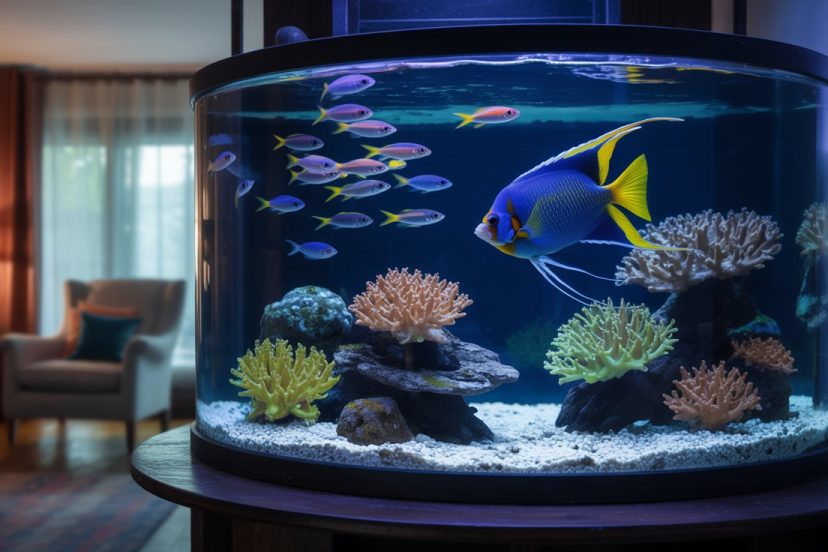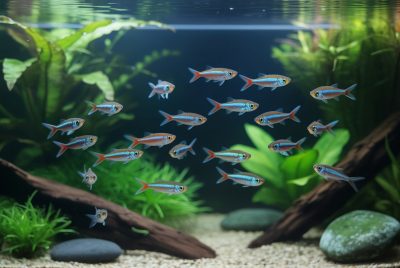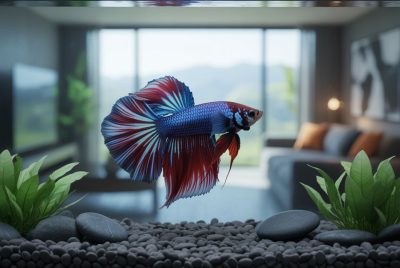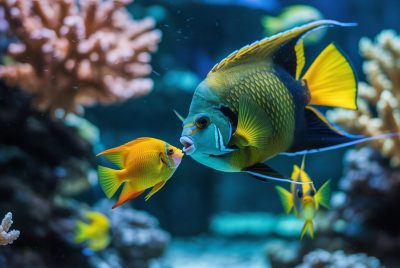Understanding pH GH and KH in Aquariums
*We may earn a commission for purchases made using our links. Please see our disclosure to learn more.
Maintaining proper pH, GH, and KH levels in aquariums is the cornerstone of successful fishkeeping. These three water chemistry parameters work together to create the stable environment that aquatic life needs to thrive. Without proper understanding and management of these essential measurements, even the most beautiful aquarium setup can quickly turn into a disaster zone.
Many aquarium enthusiasts focus heavily on equipment, decorations, and fish selection while overlooking the invisible foundation that supports all aquatic life – water chemistry. The reality is that pH (acidity/alkalinity), GH (general hardness), and KH (carbonate hardness) are interconnected systems that directly impact fish health, plant growth, and overall ecosystem stability.
This comprehensive guide explores everything aquarium owners need to know about managing these critical water parameters, from basic testing techniques to advanced troubleshooting strategies.
“Water is the driving force of all nature, and in aquariums, proper water chemistry is the driving force of all life within.”
– Marine Biology Research Institute
Key Takeaways
- pH measures acidity/alkalinity on a scale of 0-14, with most freshwater fish thriving between 6.5-7.5
- GH (General Hardness) indicates dissolved minerals, particularly calcium and magnesium
- KH (Carbonate Hardness) acts as a pH buffer, preventing dangerous pH swings
- All three parameters are interconnected and must be managed together
- Gradual changes are safer than sudden adjustments for fish health
- Regular testing and monitoring prevents catastrophic water quality issues
The Foundation of Aquatic Life: Understanding Water Chemistry
Water chemistry in aquariums operates like a complex ecosystem where every element affects another. pH, GH, and KH form the holy trinity of water parameters, each playing a distinct yet interconnected role in maintaining aquatic health.
What is pH and Why Does It Matter?
pH represents the concentration of hydrogen ions in water, determining whether your aquarium water is acidic, neutral, or alkaline. The scale ranges from 0 (extremely acidic) to 14 (extremely alkaline), with 7 being neutral.
Most freshwater fish species have evolved in specific pH ranges, and deviations can cause:
- Respiratory stress and gill damage
- Compromised immune systems
- Reduced breeding success
- Metabolic disruptions
Ideal pH ranges for common fish:
- Tetras and Angelfish: 6.0-7.0 (slightly acidic)
- African Cichlids: 7.8-8.6 (alkaline)
- Goldfish: 7.0-7.4 (neutral to slightly alkaline)
- Bettas: 6.5-7.0 (slightly acidic to neutral)
Understanding General Hardness (GH)
General Hardness measures the total concentration of dissolved minerals in water, primarily calcium and magnesium. These minerals are essential for:
- Proper gill function and osmoregulation
- Shell and bone development in invertebrates and fish
- Plant nutrient uptake
- Overall metabolic processes
GH is typically measured in degrees (°dGH) or parts per million (ppm):
- Very soft: 0-3°dGH (0-50 ppm)
- Soft: 3-6°dGH (50-100 ppm)
- Moderately hard: 6-12°dGH (100-200 ppm)
- Hard: 12-18°dGH (200-300 ppm)
- Very hard: 18+°dGH (300+ ppm)
The Buffer System: Carbonate Hardness (KH)
Carbonate Hardness, often called alkalinity, measures the water’s buffering capacity – its ability to resist pH changes. KH acts as a pH stabilizer, preventing dangerous fluctuations that can shock or kill aquatic life.
How KH works:
- High KH = stable pH, resistant to changes
- Low KH = unstable pH, prone to dangerous swings
- KH gets consumed during biological processes, requiring monitoring
The Interconnected Web of Water Parameters
Understanding how pH, GH, and KH interact is crucial for maintaining stable aquarium conditions.
The pH-KH Relationship
KH directly influences pH stability. In low KH environments, pH can fluctuate wildly due to:
- CO2 fluctuations from plant photosynthesis
- Biological waste production
- Organic matter decomposition
This relationship explains why some aquarists struggle with pH crashes in heavily planted tanks or overstocked aquariums.
GH and Fish Health Connection
While GH doesn’t directly affect pH, it impacts fish health and behavior:
- Soft water species (like tetras) can suffer in hard water conditions
- Hard water species (like many cichlids) require adequate mineral content for proper bodily functions
- Breeding success often depends on appropriate GH levels
Real-World Scenarios: When Parameters Go Wrong
Scenario 1: The pH Crash An aquarist notices their usually active community tank has become lethargic. Testing reveals a pH drop from 7.2 to 5.8 overnight. Investigation shows low KH levels couldn’t buffer against acid production from biological processes.
Solution approach:
- Immediate water change with properly buffered water
- Gradual KH increase using crushed coral or commercial buffers
- Enhanced filtration to reduce organic waste
Scenario 2: The Hard Water Struggle Soft water fish species show signs of stress in a hard water area. Despite pH being acceptable, the high mineral content affects their osmoregulation.
Solution approach:
- Use RO (reverse osmosis) water mixed with tap water
- Gradual transition over several weeks
- Regular monitoring to maintain consistent parameters
Practical Testing and Management Strategies
Essential Testing Equipment
Basic test kits should include:
- pH test kit (liquid tests are more accurate than strips)
- GH test kit
- KH test kit
- TDS (Total Dissolved Solids) meter for general monitoring
Testing frequency:
- New tanks: Daily for the first month
- Established tanks: Weekly
- Before and after water changes
- When introducing new fish or plants
Water Modification Techniques
Lowering pH and hardness:
- RO water dilution
- Peat filtration
- Driftwood addition
- CO2 injection (affects pH only)
Raising pH and hardness:
- Crushed coral substrate
- Limestone rocks
- Commercial mineral supplements
- Baking soda for KH (temporary solution)
Buffer management:
- Maintain KH between 3-8°dKH for stability
- Monitor consumption rates
- Use commercial buffer systems for consistency
Common Challenges and Solutions
Challenge 1: Inconsistent Parameters
Many aquarists struggle with fluctuating water chemistry, leading to stressed fish and poor water quality.
Root causes:
- Inadequate buffer capacity (low KH)
- Overfeeding leading to waste buildup
- Insufficient water change frequency
- Using untreated tap water with variable chemistry
Solutions:
- Establish consistent water change routine
- Test and adjust source water before use
- Maintain appropriate KH levels
- Monitor bioload and feeding practices
Challenge 2: Species-Specific Requirements
Different fish species require different water parameters, making community tanks challenging.
Approach strategies:
- Research compatibility before mixing species
- Choose fish with overlapping parameter ranges
- Create species-specific tanks when necessary
- Use gradual acclimation techniques
Challenge 3: Plant and Fish Balance
Heavily planted tanks can create pH and CO2 fluctuations that stress fish.
Management techniques:
- Monitor pH swing from lights-on to lights-off
- Maintain adequate KH for buffering
- Balance plant load with fish bioload
- Consider CO2 injection for stability
The Broader Impact: Beyond Basic Survival
Proper water chemistry management extends far beyond keeping fish alive. It influences:
Breeding success: Many species require specific water parameters to trigger spawning behaviors and ensure fry survival.
Coloration and vitality: Fish display their best colors and most natural behaviors in appropriate water conditions.
Plant growth: Aquatic plants require balanced minerals and pH for optimal photosynthesis and nutrient uptake.
Biological filtration: Beneficial bacteria perform most efficiently within specific pH and hardness ranges.
Advanced Techniques for Water Chemistry Mastery
Seasonal Adjustments
Natural water bodies experience seasonal changes, and replicating these can trigger natural behaviors:
- Gradual temperature and parameter shifts
- Simulating rainy season with softer water
- Dry season simulation with concentrated parameters
Breeding Preparation
Many species require specific water chemistry for successful reproduction:
- Research wild habitat parameters
- Gradually adjust to breeding conditions
- Maintain stability during spawning and fry development
Long-term Monitoring
Successful aquarists develop systems for consistent monitoring:
- Keep detailed logs of parameters and fish behavior
- Track parameter trends over time
- Identify patterns related to feeding, maintenance, and seasonal changes
Prevention and Maintenance: The Path to Success
Establishing Routines
Consistent maintenance prevents most water chemistry problems:
- Weekly testing schedule
- Regular water changes with pre-tested water
- Equipment calibration and maintenance
- Proactive buffer management
Emergency Preparedness
Prepare for parameter emergencies:
- Keep emergency water supplies treated and ready
- Maintain backup testing equipment
- Know how to make safe, gradual adjustments
- Have contact information for local aquarium professionals
Community Resources
Connect with other aquarists for support and knowledge sharing:
- Local aquarium societies
- Online forums and communities
- Educational workshops and seminars
- Mentorship with experienced hobbyists
Celebrating Small Victories in Water Chemistry Management
Success in aquarium water chemistry comes through small, consistent victories:
- Achieving stable parameters for a full month
- Successfully breeding a challenging species
- Maintaining crystal-clear water with thriving inhabitants
- Helping another aquarist solve their water chemistry challenges
Each milestone represents growing expertise and confidence in creating optimal aquatic environments.
The Continuous Journey of Aquatic Mastery
Water chemistry management in aquariums represents an ongoing journey of learning and refinement. As aquatic ecosystems evolve, so too must the understanding and management approaches of their caretakers.
The interconnected nature of pH, GH, and KH requires a holistic approach to aquarium management. Success comes not from perfect numbers on test kits, but from creating stable, balanced environments where aquatic life can thrive naturally.
Whether you’re just beginning your journey into water chemistry or seeking to refine advanced techniques, remember that every expert was once a beginner. The key lies in consistent monitoring, gradual adjustments, and continuous learning from both successes and setbacks.
Conclusion
Mastering pH, GH, and KH in aquariums transforms fishkeeping from a series of reactions to problems into proactive ecosystem management. These three parameters work together to create the foundation upon which all aquatic life depends.
The journey to water chemistry mastery requires patience, consistency, and a willingness to learn from both successes and failures. By understanding the interconnected nature of these parameters and implementing consistent testing and management practices, aquarists can create thriving aquatic environments that support healthy, vibrant fish and plant communities.
Remember that stable water chemistry isn’t about achieving perfect numbers – it’s about creating consistent, appropriate conditions for your specific aquatic inhabitants. Focus on gradual changes, consistent monitoring, and building the knowledge base that allows for confident decision-making when challenges arise.
The reward for this dedication extends far beyond healthy fish: it’s the deep satisfaction of successfully managing a complex aquatic ecosystem and the joy of watching aquatic life flourish under your care.
Frequently Asked Questions
1. How often should I test pH, GH, and KH in my aquarium?
For new aquariums (first 2 months), test these parameters 2-3 times per week to establish stability patterns. For established aquariums, weekly testing is typically sufficient, though you should test more frequently if you notice changes in fish behavior, after adding new fish, or when making any adjustments to your system. Always test before and after water changes to ensure consistency.
2. Can I use baking soda to raise KH, and is it safe for fish?
While baking soda (sodium bicarbonate) can temporarily raise KH, it’s not the best long-term solution as it primarily adds sodium rather than calcium and magnesium carbonates. It’s safer to use commercial aquarium buffers or natural methods like crushed coral. If you must use baking soda in emergencies, dissolve it completely in water before adding and make gradual adjustments over several days.
3. Why do my parameters keep fluctuating despite regular water changes?
Fluctuating parameters usually indicate insufficient buffering capacity (low KH) or inconsistent source water. Test your tap water parameters regularly, as municipal water can vary seasonally. Ensure your KH is at least 3-4°dKH for basic buffering. Also check for bioload issues – overstocking or overfeeding can overwhelm your buffer system and cause parameter swings.
4. Is it better to have slightly wrong parameters that are stable, or correct parameters that fluctuate?
Stable parameters that are slightly outside the ideal range are almost always better than correct but fluctuating parameters. Fish can adapt to consistent conditions over time, but sudden changes cause stress and can be lethal. If your stable parameters are significantly outside the ideal range for your species, make very gradual adjustments over weeks or months.
5. Do live plants significantly affect pH, GH, and KH levels?
Live plants primarily affect pH through CO2 consumption during photosynthesis, potentially causing daily pH fluctuations. They have minimal direct impact on GH and KH, though they may slightly reduce these parameters over time by consuming minerals. In heavily planted tanks, maintain adequate KH (4-6°dKH) to buffer against pH swings, and monitor the difference between lights-on and lights-off pH levels to ensure they stay within safe ranges.




